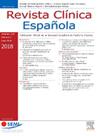2019 年冠状病毒病无声低氧血症患者死亡的风险因素
IF 1.7
4区 医学
Q2 MEDICINE, GENERAL & INTERNAL
引用次数: 0
摘要
材料和方法对 2021 年 1 月至 6 月期间巴西因 COVID-19 感染严重急性呼吸系统综合征(SARS)且入院时出现无声低氧血症的住院患者进行回顾性队列研究。主要研究结果为住院死亡。结果 在 46 102 名患者中,平均年龄为 59 ± 16 岁,女性占 41.6%。住院期间,13149 名患者死亡。与幸存者相比,非幸存者年龄更大(平均年龄为 66 岁对 56 岁;P < 0.001),女性更少(43.6% 对 40.9%;P < 0.001),更有可能患有合并症(74.3% 对 56.8%;P < 0.001)。与存活者相比,非存活者对有创机械通气(42.4% 对 6.6%;P <;0.001)和入住重症监护室(56.9% 对 20%;P <;0.001)的需求更高。在多变量回归分析中,高龄(OR:1.04;95%CI:1.037-1.04)、合并症(OR:1.54;95%CI:1.47-1.62)、咳嗽(OR:0.74;95%CI:0.71-0.79)、呼吸困难(OR:1.32;95%CI:1.26-1.38)和需要无创呼吸支持(OR:0.37;95%CI:0.35-0.40)仍然与死亡独立相关。结论对于因COVID-19引起的SARS住院病人来说,高龄、合并症和呼吸窘迫是导致死亡的独立危险因素,而咳嗽和需要无创呼吸支持则是导致死亡的独立保护因素。本文章由计算机程序翻译,如有差异,请以英文原文为准。
Factores de riesgo de mortalidad en pacientes con enfermedad del coronavirus 2019 con hipoxemia silente
Objective
To describe the predictors of mortality in hospitalized patients with severe acute respiratory syndrome (SARS) due to COVID-19 presenting with silent hypoxemia.
Material and methods
Retrospective cohort study of hospitalized patients with SARS due to COVID-19 and silent hypoxemia at admission, in Brazil, from January to June 2021. The primary outcome of interest was in-hospital death. Multivariable logistic regression analysis was performed.
Results
Of 46,102 patients, the mean age was 59 ± 16 years, and 41.6% were female. During hospitalization, 13,149 patients died. Compared to survivors, non-survivors were older (mean age, 66 vs. 56 years; P < 0.001), less frequently female (43.6% vs. 40.9%; P < 0.001), and more likely to have comorbidities (74.3% vs. 56.8%; P < 0.001). Non-survivors had higher needs for invasive mechanical ventilation (42.4% vs 6.6%; P < 0.001) and intensive care unit admission (56.9% vs 20%; P < 0.001) compared to survivors. In the multivariable regression analysis, advanced age (OR: 1.04; 95%CI: 1.037-1.04), presence of comorbidities (OR: 1.54; 95%CI: 1.47-1.62), cough (OR: 0.74; 95%CI: 0.71-0.79), respiratory distress (OR: 1.32; 95%CI: 1.26-1.38), and need for non-invasive respiratory support (OR: 0.37; 95%CI: 0.35-0.40) remained independently associated with death.
Conclusions
Advanced age, presence of comorbidities, and respiratory distress were independent risk factors for mortality, while cough and requirement for non-invasive respiratory support were independent protective factors against mortality in hospitalized patients with SARS due to COVID-19 with silent hypoxemia at presentation.
求助全文
通过发布文献求助,成功后即可免费获取论文全文。
去求助
来源期刊

Revista clinica espanola
医学-医学:内科
CiteScore
4.40
自引率
6.90%
发文量
73
审稿时长
28 days
期刊介绍:
Revista Clínica Española published its first issue in 1940 and is the body of expression of the Spanish Society of Internal Medicine (SEMI).
The journal fully endorses the goals of updating knowledge and facilitating the acquisition of key developments in internal medicine applied to clinical practice. Revista Clínica Española is subject to a thorough double blind review of the received articles written in Spanish or English. Nine issues are published each year, including mostly originals, reviews and consensus documents.
 求助内容:
求助内容: 应助结果提醒方式:
应助结果提醒方式:


